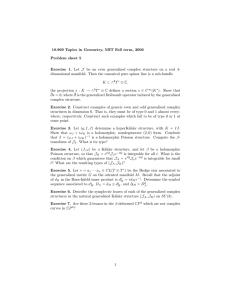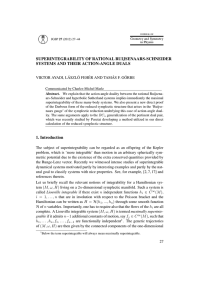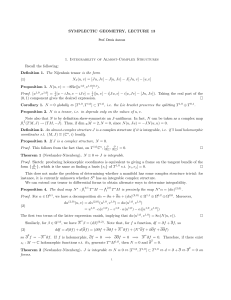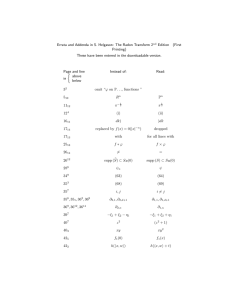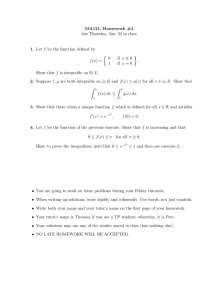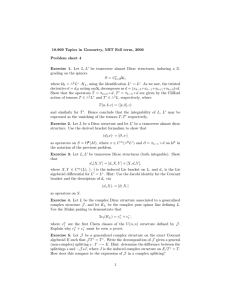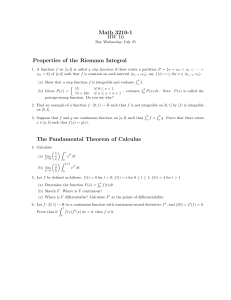12 Lecture 12-17(Notes: K. Venkatram)
advertisement
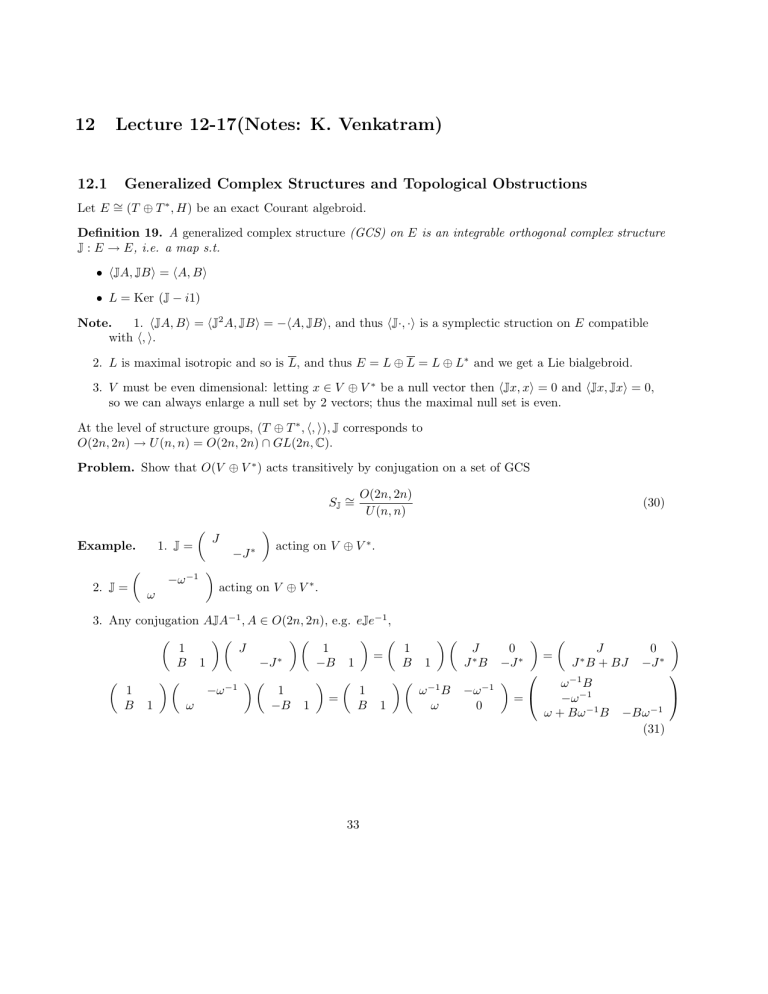
12
Lecture 12-17(Notes: K. Venkatram)
12.1
Generalized Complex Structures and Topological Obstructions
Let E ∼
= (T ⊕ T ∗ , H) be an exact Courant algebroid.
Definition 19. A generalized complex structure (GCS) on E is an integrable orthogonal complex structure
J : E → E, i.e. a map s.t.
• �JA, JB� = �A, B�
• L = Ker (J − i1)
Note.
1. �JA, B� = �J2 A, JB� = −�A, JB�, and thus �J·, ·� is a symplectic struction on E compatible
with �, �.
2. L is maximal isotropic and so is L, and thus E = L ⊕ L = L ⊕ L∗ and we get a Lie bialgebroid.
3. V must be even dimensional: letting x ∈ V ⊕ V ∗ be a null vector then �Jx, x� = 0 and �Jx, Jx� = 0,
so we can always enlarge a null set by 2 vectors; thus the maximal null set is even.
At the level of structure groups, (T ⊕ T ∗ , �, �), J corresponds to
O(2n, 2n) → U (n, n) = O(2n, 2n) ∩ GL(2n, C).
Problem. Show that O(V ⊕ V ∗ ) acts transitively by conjugation on a set of GCS
O(2n, 2n)
SJ ∼
=
U (n, n)
�
Example.
1. J =
−ω −1
�
2. J =
ω
�
J
−J ∗
�
(30)
acting on V ⊕ V ∗ .
acting on V ⊕ V ∗ .
3. Any conjugation AJA−1 , A ∈ O(2n, 2n), e.g. eJe−1 ,
�
��
��
� �
��
� �
�
1
J
1
1
J
0
J
0
=
=
B 1
−J ∗
−B 1
B 1
J ∗ B −J ∗
J ∗ B + BJ −J ∗
⎛
⎞
�
��
��
� �
� � −1
�
ω −1 B
−1
−1
1
−ω
1
1
ω B −ω
⎠
−ω −1
=
=⎝
B 1
ω
−B 1
B 1
ω
0
ω + Bω −1 B −Bω −1
(31)
33
Lemma 3. O(n.n) � O(n) × O(n).
⊥
. THen O(n, n) acts transitively on the space of
Proof. Let C+ ⊂ V ⊕ V ∗ be positive definite and C− = C+
O(n,n)
�
all C+ , with stabilizer Stab(C+ ) = O(n) × O(n). Question: what is O(n)×O(n)
? C+
(see diagram below) is
n
n
given by A : R → R , ||Ax|| < ||x||∀x, i.e. ||A||op < 1. Thus, it is the unit ball under the operator
norm.
Lemma 4. U (n, n) � U (n) × U (n)
Proof. We can enlarge C̃+ to C+ by adding V ⊥ C̃+ and JV , and get complex decomposition
⊥
E = C+ ⊕ C+
= C+ + C− . U (n, n) acts transitively on these spaces with stabilizer
Stab(C+ ) = U (n) × U (n). As above, we obtain the unit ball in Cn .
Thus, the existence of J is topologically equivalent to the reduction to U (n) × U (n), i.e. complex structures
⊥
(since the bundle of positive-definite subspaces is contractible).
J± := J|C± on C+ and C− = C+
Note. The projection π : C± → T is an isomorphism, so we obtain almost complex structure J± : T → T .
2i
Thus M must be almost complex, and J has two sets of Chern classes c±
i ∈ H (M, Z) associated to J±
±
∗
(i.e. ci = ci (c± )) and c(T ⊕ T , J) = c(C+ ) ∪ c(C− ).
Remark. Topologically, E has structure group U (n, n) � U (n) × U (n), so the bundle is classified by
ψ : X → B(U (n) × U (n)) = BU (n) × BU (n) = C + × C − with Chern classes ψ ∗ C + , ψ ∗ C − .
Now, spaces L ⊂ T ⊕ T ∗ correspond to canonical bundes KL ⊂ Ω∗ (M ).
Proposition 5. A generalized complex structure is equivalent to a complex Dirac structure of real index 0,
i.e. to a Dirac structure L ⊂ (T ⊕ T ∗ ) ⊗ C s.t. L ∩ L = {0}.
Proof. ⇐: given L, set J = i|L + (−i)|L , and obtain
�J(α + β), J(α + β)� = �iα − iβ, iα − iβ� = �α, β� + �β, α� = �α + β, α + β�
(32)
→: given J, set L = Ker (J − i1), so
�α, β� = �Jα, Jβ� = −�α, β� = 0
(33)
Therefore, (T ⊕ T ∗ ) ⊗ C = L ⊕ L, and we obtain a transverse complex Dirac structure. This gives us a
Z-grading on S ⊗ C = Ω∗ (M, C) as
(KL = Un ) ⊕ Un−1 ⊕ · · · ⊕ U−n+1 ⊕ (U−n = KL )
(34)
with conjugation exchanging Uk and U−k .
Definition 20. KL = U−n is the canonical line bundle of the generalized complex structure.
Furthermore, the decomposition dH = ∂ + ∂ gives the general Dolbeault complex via ∂ : Uk ↔ Uk−1 : ∂.
Problem. Use the Mukai pairing between KL and K L to show that 2c1 (KL ) = c∗1 + c−
1.
34
12.1.1
Z-grading on spinors
Let J be a generalized complex structure: then J ∈ so(T ⊕ T ∗ ). The transformtation eθJ behaves like eiθ
and thus defines an S 1 action on T ⊕ T ∗ and thus, by the spin representation, on on Ω∗ (M ) (in fact, we
can imagine this as cos θ · 1 + J · sin θ). Just as (T ⊕ T ∗ ) ⊗ C decomposes as L ⊕ L, we have
J(x, φ) = [J, x] · φ + x · Jφ, where [J, x] is the so-action. Thus, for an eigenvector x ∈ L, Jx = ix, then
Jxφ = xJφ + iφ. That is, the action of L increases by i, while L decreases by i, givng us a diagram
L
KL = U−n �
�
L
···
U−n+1
Un−1 �
L
�
Un = KL
(35)
L
Since the eigenvalues are symmetric, they must be {−ni, (−n + 1)i, . . . , ni}, with Uk the ik-eigenspace of J.
Now, via the decomposition dH = ∂ + ∂, we can form another real differential operator
dJ = [d, J] = [∂ + ∂, J]. Applying this to φk gives
[d, J]φk = ik(∂ + ∂)φ − i(k + 1)∂φ − i(k − 1)∂φ = i(∂ − ∂)φ
(36)
Thus, dJ = i(∂ − ∂), and (dJ )2 = 0 as desired. �
∗
For each GCS, we obtain three complexes: (C ∞ ( L∗ ), dL ) and the pair (U ∗ , ∂), (U ∗ , ∂).
�∗
Proposition 6. (C ∞ ( L∗ ), dL ) is elliptic.
Recall that in general, this is not true. In particular, in the case of Poisson structures, the complex is
infinite dimensional.
Proof. Since L is a Lie algebra, we obtain a symbol sequence
k−1
�
L∗ →Sξ
k
�
L∗ →Sξ
k+1
�
L∗
(37)
where Sξ (φ) = π ∗ ξ ∧ φ for a given ξ ∈ T ∗ real. If ξ �= 0, it can be decomposed as α + α ∈ L ⊕ L with α =
� 0.
Moreover, for x ∈ L, we have
(π ∗ ξ)(x) = ξ(πx) = �ξ, x� = �α + α, x� = �α, x�
(38)
so π ∗ ξ = α is nonzero.
Corollary 4. H ∗ (L), H ∗ (L) are finite dimensional on compact generalized complex manifolds.
For the other complex, we have that dH (f φ) = df ∧ φ + f dH φ = (dL f + dL f )φ + f dH φ, so that
∂(f φ) = (dL f )φ + f ∂φ.
�k
Problem. Using the right derived bracket, show that (dL x)· = [∂, x·] for x ∈ C ∞ ( L∗ ).
By the above, we have a symbol sequence U k−1 ←Sξ U k ←Sξ U k+1 given by the anihilation operator
Sξ (φ) = αφ which is also an exact sequence. Doing a similar procedure for ∂, and following the above logic
(replacing the Clifford action with the wedge product), we obtain:
Corollary 5. H∂∗ (M ), H∂∗ (M ) are finite dimensional for compact generalized complex manifolds.
∗
Remark. One has a spectral sequence H∂,∂
(M ) =⇒ Hd∗H (M ). Moreover, this spectral sequence is trivial
�
(i.e. Hd∗H =
H∂∗ (M ) if the ∂∂-lemma holds for M : if ∂α = 0 and α = ∂β, then α = ∂∂γ for some γ. In
other words,
Im ∂ ∩ Ker ∂ = Ker ∂ ∩ Im ∂ = Im ∂∂
35
(39)
Finally, we obtain actions of H ∗ (L), H ∗ (L) on H∂∗ (M ), H∂∗ (M ) respectively via
∂(x · φ) = (dL x) · φ + (−1)x x · ∂φ, x ∈
k
�
(40)
L
Problem. Show the above statement.
This statement implies dL x = [∂, x], so dL x = 0, ∂φ = 0 =⇒ ∂(x · φ) = 0, making the action well-defined.
12.1.2
Complex Case
�
Given an almost-complex structure J, we obtain a generalized complex structure JJ =
claim that JJ is integrable w.r.t. [, ] ⇔ J is integrable. To see this, decompose L = T0,1 ⊕
elements x, y ∈ T0,1 , ξ, η ∈ T1∗,0 . One obtains
�
. We
−J
T1∗,0 ,
J∗
and choose
[x, y] + Lx η − iy dξ = [x, y] + ix ∂η − iy ∂ξ
where [x, y] ∈ T0,1 ⇔ J is integrable, and Lx η = ix dη = ix (∂η + ∂η) = ix ∂η because ∂η ∈
does not survive ix .
(41)
�2
∗
T0,1
and thus
Remark. Adding a term ix iy H to the above expression, where H =
� 0, we find that
ix iy H ∈ T1,0 ∀x, y ∈ T0,1 ⇔ H (0,3) = 0, i.e. the gerbe is homogeneous. This is similar to the fact that
F (2,0) = 0 for (L, �) holomorphic.
We have two different complexes:
�∗
1. First, the complex (C ∞ ( L∗ ), dL ), where
k
�
L∗ =
p
p
�
� �
( T1,0 ) ⊗ ( T0∗,1 )
(42)
p+q=k
and the differential map is given by the individual partials
∂ : C ∞(
That is, each of the bundles
k
H (L) =
�p
�
p
�
T1,0 ⊗
p
�
p
p�
+1
�
T0∗,1 ) → C ∞ ( T1,0 ⊗
T0∗,1 )
(43)
T1,0 has a ∂ operator and dL is their sum. This implies that
p
k�
−1
�
0
k
1
H ( T1,0 ) = H (∧ T1,0 ) ⊕ H (
T1,0 ) ⊕ · · · ⊕ H k (Ø)
q
(44)
p+q=k
k
2. Second, we have the complex
, ∂) as defined above. Note first that, being the canonical bundles,
�n (U
we have that KL = U n =
T1∗,0 = Ωn,0 (similarly, KL = U −n = Ωn,0 . By the decomposition
L = T0,1 + T1∗,0 , we find that L acts on each Ωk,l by either increasing k or decreasing l, giving us our
sequence as the decomposed Hodge diamond
�
� � 0,0 �
�
�
�
� �
�
�
�
� 0,n−1 � � Ω
�
� n−1,0 �
� � .. �
� Ω
� n,0
0,n � Ω
KL = Ω �
(45)
�· · · �
�···�
� Ω = KL
� Ω1,n � � . �
� Ωn,1 �
n,n
�
� � Ω
�
�
�
�
That is, U k = p−q=k Ωp,q , with the boundary maps given by the usual ones on Ω and
�
k
H∂k (M ) = p−q=k H�d
(M ).
∂
36
12.1.3
Symplectic Case
−ω −1
�
Given a symplectic form ω, we obtain a generalized complex structure Jω =
�
�
x
i-eigenvector
, we have
ξ
�
ω
. Given an
ω(x) − ω −1 (ξ) = ix + iξ =⇒ iη = ω(x)
(46)
Thus, L = {x − iω(x) : x ∈ T ⊗ C} = Γ−iω , where Γ−iω denotes the graph of −iω : T ⊗ C → T ∗ ⊗ C, is a
simple Dirac structure. Moreover, Ωσ is integrable w.r.t. [, ]H ⇔ dH σ = 0. In our case, we have
d(−ω) = −H ∧ (−iω), so dω and H must be 0 (i.e. ω is symplectic). We again get two complexes
�∗
�∗
k
∼ k
1. (C ∞ ( L∗ )dL ) ∼
= (C ∞ ( T ∗ ⊗ C), d) is
�∗trivial, and H (L) = HdR (M ). However, one does have a
nontrivial Gerstenhaber structure (C ∞ ( L∗ ), dL , [, ]∗ ), and one has an equivalence between (L, L)
and (T ⊗ C, Γ(∂iω)−1 ) (the Lie bialgebroid of a complex Poisson structure).
2. The ends of the complex (U k , ∂) can be simply exhibited as KL = �eiω �, KL = �e−iω �. The next term
can be computed via
U −n+1 = (X − iωX)e−iω = −iω(x) ∧ e−iω − iω(x) ∧ e−iω = eiω · Ω1
The higher terms are more complicated: given general invertible σ, the transformation e−σ e
T ⊕ T ∗ sends T ∗ → Γσ (i.e. 1 → eσ ) and T → Γ−σ (i.e. Ωn → e−σ ). Thus, we find that
U k = eiω e
ω −1
2i
(47)
σ −1
2
Ωn−k
on
(48)
Λ
Letting L, Λ denore the maps φ �→ ω ∧ φ, φ �→= �
−iω−1 φ, we
the expression
U k = eiL e− 2i Ωn−k .
� obtain
�
�
ω −1
These maps arise via the decomposition of J as
+
. Setting
−ω
�
� �
� �
�
0 0
1 0
1 0
H = [L, Λ] =
−
=
(49)
0 −1
0 0
0 −1
we find that [H, L] = −2L and [H, Λ] = 2Λ. These are precisely the sl2 R commutator relations,
giving us associated actions on the symplectic manifold. In particular, H acts as
Hφ =
1
tr(id) − (id∗ )φ = sum(n − k)πk φ
2
(50)
where πk : Ω → Ωk is the projection. Via our decomposition of J, we find that
dJ = [d, L + Λ] = [d, Λ] = δ is a degree −1 operator with δ 2 = 0 (called the symplectic adjoint of d)
and ∂ = d − iδ : U k → U k−1 . Using an analogous dδ (or ∂∂) lemma for symplectic manifolds, we find
∗
has a δ-closed representation (since δα = δdγ and d(α − γ) = 0,
that any cohomology class α ∈ HdR
implying that δ(α − dγ) = 0). Thus, �
setting α̃ = α − γ, we find that
˜ = 0 ⇔ [d, Λ]α̃ = 0 =⇒ d( α̃) = 0. These statements combine to give an action of (L, Λ)
[d, J]alpha
on cohomology, i.e. an sl2 R action on H ∗ (M ). Furthermore, Ln−k : H k → H 2n−k is an isomorphism,
implying an equivalence between the dδ-lemma and the Lefshetz properlty (see Cavalcanti thesis for
⇐).
37
12.2
Intermediate Cases
We have studied
�
JJ =
�
J
−J ∗
�
, Jω =
−ω −1
ω
�
(51)
What about the intermediate cases?
• intermediate types and spinors
• Poisson structure
• Local form
• Examples of type jumping by deformation
• interpolation
Given a complex bundle T ∗ → E →π T , let J � E with JT ∗ = T ∗ . Then T ∗ ⊂ E is a complex subspace,
and E/T ∗ = T obtains an almost complex structure J which is integrable. Furthermore,
(Jξ)(X) = �Jξ, X̃� = −�ξ, Jx̃� = ξ(Jx) = −J ∗ ξ(X)
(52)
i.e. J|T ∗ = −J ∗ .
12.2.1
Complex and Symplectic Decompositions
Let S : T → E be any splitting, i.e. π ◦ s = id|T . Then we can produce a complex splitting by averaging
1
(S − JsJ) = S �
2
(53)
Note. π(−JsJ)(X) = π(−J(s(JX))) = −J 2 X = X, so −JxJ is a splitting.
�
�
J
Observe that, in splitting S � : E → T ⊕ T ∗ , we obtain J =
.
−J ∗
Problem. Write J is a non-complex splitting using S. Hint: what is the difference between the splittings
S and −JSJ?
Finally, assume that JT ∗ ∩ T ∗ = {0}. Then E = T ∗ ⊕ JT ∗ and, in this splitting,
�
�
−ω −1
J=
ω
(54)
where ω(X, Y ) = �JxX, xY �.
12.2.2
General case
In general, T ∗ + JT ∗ is a complex subspace of E, as is T ∗ ∩ J∗ T ∗ ⊂ T ∗ + JT ∗ ⊂ E.
Definition 21. Δ = π(T ∗ + JT ∗ ) = πJT ∗ .
Note that
Ann Δ = (T ∗ + JT ∗ )⊥ ∩ T ∗ = T ∗ ∩ JT ∗ ∩ T ∗ = T ∗ ∩ JT ∗
∗
∗
(55)
+JT ∼
∗
∗
∗
is complex, and TAnn
Δ = Δ ⊕�J Δ has symplectic structure. Also, E/(T + JT ) = T /Δ has a complex
structure, with complex dimension k (called the type).
38
Theorem 8. M is generally foliated by symplectic leaves with transverse complex structure.
Lemma 5. JT ∗ is Dirac.
Proof. Observe first that the +i eigenspace is closed, i.e.
z − iJz = [x − iJx, y − iJy]
= [x, y] − [Jx, Jy] − i([x, Jy] + [Jx, y])
[x, Jy] + [Jx, y] = J[x, y] − J[Jx, Jy]
[Jx, Jy] = [x, y] + J([x, Jy] + [Jx, y])
(56)
Thus, [Jξ, Jη] = [ξ, η] + J([ξ, Jη] + [Jξ, η]) = Jα (note that πα = 0 =⇒ α ∈ T ∗ ).
Problem. Show that NJ (x, y) = [Jx, Jy] − J[x, Jy] − J[Jx, y] − [x, y] is tensorial and express it in terms of
T, T � .
Problem. eθJ T ∗ is Dirac ∀θ. Hint: eθJ T ∗ = ((cos θ · 1) + (sin θ)J)(T ∗ ) = (1 + tan θJ)T ∗ , and
(57)
[ξ + tJξ, η + tJη] = t([ξ, Jη] + [Jξ, η]) + t2 J([ξ, Jη] + [Jξ, η]) = (1 + tJ)(t([ξ, Jη] + [Jξ, η]))
�
3 ∗
π H.
Lemma 6. For small θ, eθJ T ∗ is a twisted Poisson structure in a splitting satisfying [π, π] =
d
Taking the derivative dθ
(eθJ T ∗ ) at θ = 0, we obtain a tangent vector to Dir(T ⊕ T ∗ ) at T ∗ : this is a skew
�2
d
∗
map T → T , i.e. an element π ∈ C ∞ ( T ) s.t. [θπ, θπ] = θ3 π ∗ H =⇒ [π, π] = 0. Thus, dθ
(eθJ T ∗ ) = π,
and π : ξ �→ πT Jξ is a Poisson structure, and we can split
�
�
A
π
J=
(58)
σ −A∗
The proof of the theorem follows from the following two observations:
1. Δ = Im (π) is the image of a Poisson structure and thus a generalized distribution.
2. The symplectic structure on Δ agrees with π, i.e. for ξ, η ∈ Δ∗ , ω −1 (ξ, η) = �Jξ, η� = π(ξ, η).
12.2.3
Weinstein Splitting
Now, assume that the foliation is of locally constant rank near p ∈ M .
Theorem 9 (Weinstein Splitting). For any p ∈ (M, π) Poisson, there exist coordinates
(q1 , . . . , qr , p1 , . . . , pr , y1 , . . . , y� ) s.t.
π=
r
�
�
�
∂
∂
∂
∂
∧
+
φ(y)
∧
∂qi ∂pi i,j=1
∂yi ∂yj
i=1
(59)
with φ(0) = 0.
Note.
• When � = 0, this is the Darboux theorem.
• When the rank at p is locally constant, φ = 0 in a neighborhood of p. (Lie’s Theorem)
If the rank is locally constant, then J induces a complex structure J on �y1 , · · · , y2k � which is integrable
since (πx, πy) = π(x, y). Moreover, it is independent of the {pi , qi }, as
[Jdpi , Jdyj ] = J(d{pi , yj }) = 0
and similarly for q. This gives us a local coordinate system R2(n−k) × Ck .
39
(60)
12.2.4
Examples of type jumping
�
−J
Given a complex structure JJ =
�
and spaces
J∗
L = T0,1 ⊕ T1∗,0 ,
2
�
L∗ =
2
�
T1,0 ⊕ (T1,0 ⊗ T0∗,1 ) ⊕
2
�
(61)
T0∗,1
�2 ∗
we can examine deformations � ∈
L s.t. d� + 12 [�, �] = 0.
�2
Example. For � ∈
T1,0 ,
�2
�
3
�
�
1
T1,0 ⊗ T0∗,1 ⊕ T1,0 � ∂� + [�, �] = 0 =⇒ ∂� = 0, [�, �] = 0
2
(62)
i.e. � is a holomorphic Poisson structure.
By construction,
�
1
�
�
1
��
L
L
�
=1+�+�
Letting P = � + �, we obtain a transformation JJ →
� ep Je−P ,
�
��
��
� �
��
� �
1 P
J
1 −P
1 P
J −JP
J
=
=
1
1
1
0 −J ∗
0
−J ∗
(63)
−JP − P J ∗
−J ∗
�
�
=
PJ
2Q
−J ∗
(64)
for Q = i(� − �). Thus, the type is given by n − rkQ.
�2
Example. On CP 2 ,
T1,0 = O(3), and � ∈ H 0 (O(3)).
12.3
Spinorial Description
Recall that J determines as is determined by the +i-eigenbundle L. Set pi : L → T ⊗ C to be the map
π(L) = E ⊂ T ⊗ C. Since L = L(E, �), kL = �e� Ω�, i.e. kL is generated by products φ = eB+iω θ1 ∧ · · · ∧ θk
when �θ1 , . . . , θk � = Ann E.
Note. However,
1. Let ξ ∈ T ∗ be real: then ξ = α + α ∈ L ⊕ L =⇒ Jξ = i(α + α) and
π(α) + π(α) = 0 =⇒ π(Jξ) = iπ(α − α) = 2iπ(α) = −2iπ(α). Therefore E ∩ E = Δ ⊗ C, with
Ann Δ = �Ω ∧ Ω�, and k is the type of J.
2. f ∗ ω is nondegenerate on Δ, as
�φ, φ� =
� 0 ⇔ �eB+iω Ω, eB−iω Ω� =
� 0 ⇔ �e2iω Ω, Ω� =
� 0 ⇔ ω n−k ∧ Ω ∧ Ω �= 0.
Problem. Show that ω −1 = π|Δ .
2(n−k)
Given coordinates (x1 , . . . , xn−k , p1 , . . . , pn−k , z1 , . . . , zk ) for Rω0
× Ck , ω0 = ω |Δ , J has a general spinor
B+iω
φ=e
dz1 ∧ · · · ∧ dzk around each regular point. Here, we are fixing the splitting so that H = 0. Now,
dφ = α · φ = (X + ξ) · φ = d(B + iω) ∧ φ: by degree considerations, iX Ω = 0 and iX (B + iω) + ξ = 0, so
dφ = 0 and d(B + iω) ∧ Ω = 0, giving us ∞-integrability.
40
�
Theorem 10. φ = eB
�
+iω0
2(n−k)
Ω with B � closed, i.e. J is equivalent to Rω0
× Ck .
Proof. The general strategy is to transfer to some eB+iω Ω and use the freedom available to make B closed.
2(n−k)
× Ck , we have a decomposition d = df + ∂ + ∂. Set A = B + iω: then A
Using the splitting on Rω0
breaks up into a triangle
⎛ 200
⎞
A
⎝ A110 A101
⎠
(65)
020
011
002
A
A
A
which acts effectively via exponentiation on Ω0k0 . Note that, via averaging, we have
ω0 = ω|Δ = 2i (A200 − A200 ). Our goal is to modify the triangle (A110 , A020 , A011 ) so that A101 , A002 enter
only in the real part of A. To this end, let C 011 be any real form, and set
A� = A200 + (A101 + A101 ) + (A002 + A002 ) + C 011
�
�
1 200
1
101
002
011
200
101
002
=
(A + A ) + A + A + A + A + C
+ (A200 + A200 ) = B � + iω0
2
2
(66)
The condition that dA ∧ Ω = 0 gives four constraints on the Aijk :
(a)df A200 = 0
(b)∂A200 + df A101 = 0
(c)∂A101 + df A002 0
(67)
(d)∂A002 = 0
The desire for B � to be closed requires (dB � )012 = (dB � )111 = 0, which gives the following two constraints:
∂A002 + ∂C = 0
∂A101 + df C + ∂A101 = 0
(68)
We obtain the desired C via the Dolbeault lemma. For the first constraint, note that (d)
=⇒ A002 = ∂α001 . Thus
(1) ⇔ ∂C + ∂∂α = 0 ⇔ ∂(C − ∂α) = 0 ⇔ ∂(C − ∂α − ∂α) = 0
⇔ C − ∂α − ∂α = ∂ψ ⇔ C = ∂α + ∂α + i∂∂χ
(69)
for χ a real function. For the second constraint, note that (c) is true
⇔ 0 = ∂A101 + df A002 = ∂(A101 − df α) =⇒ A101 = df α + ∂β 100 for β a 100-form. This implies that
(2) ⇔ ∂(df α + ∂β) + ∂(df α + ∂β) + df (∂α + ∂α + i∂∂χ) = 0 ⇔ ∂∂(β − β) = idf ∂∂χ
Moreover, (b) is true ⇔ ∂A200 + df A101 = 0 ⇔ df ∂β = −∂A200 . Thus,
df ∂∂(β − β) = ∂∂(A200 − A200 ) = 0, so we can choose the desired χ.
Corollary 6. A GCS on an exact Courant algebroid is locally equivalent, near a regular point, to
2(n−k)
Rω0
× Ck .
41
(70)
12.3.1
More Examples of Type Jumping
Recall that we say type jumping via the operator eβ+β JJ e−(β+β) . We can see this behavior more explicitly
2
using forms.
�2 Recall that a complex structure on C a representation by a spinor φ = dz1 ∧ dz2 . Let
0
β ∈ H ( T ) be a holomorphic section, e.g. β = z1 ∂1 ∧ ∂2 (obviously holomorphic). Then
eβ φ = eβ+β φ = dz1 ∧ dz2 + iz1 ∂1 ∧∂2 dz1 ∧ dz2 = z1 + dz1 ∧ dz2
(71)
At z1 = 0, this gives the complex structure dz1 ∧ dz2 . Outside z1 = 0, we have z1 (1 +
2
where B + iω = dz1z+dz
.
1
12.3.2
dz1 +dz2
)
z1
∼ eB+iω ,
Interpolation
Suppose (g, I, J) is a Hyperk ahler structure, i.e. (I, g), (J, g) are K ahler and IJ = −JI. Then (K = IJ, g)
is another integrable K ahler structure, and one obtains a family of complex structures
{aI + bJ + cK|a2 + b2 + c2 = 1} parameterized by S 2 , all of which are K ahler w.r.t. g.
Remark. This places a strong constraint on g (reduction of holonomy, Ricci-flat metric, i.e. Einstein) but
does not imply that the Riemann curvature is 0. The only known compact examples known are
• K3 surface
• Flat T 4
• Hilbn (K3)
• Hilbn (T 4 )
• Two examples in dimensions 12 and 20 (O’Grady).
Setting ωJ I = gJ, ωK = gK, one obtains
wJ I = gJI = −gIJ = I ∗ gJ = I ∗ ωJ
Moreover, considering the GCSs
�
�
�
I
JI =
, JωJ =
−I ∗
ωJ
−ωJ−1
�
(72)
−ωk−1
�
, JωK =
�
ωk
(73)
one obtains the relations
�
JI JωJ =
−I ∗ ωJ
−IωJ−1
�
−ωJ−1 I ∗
�
=
−ωJ I
�
= −JωJ JI
(74)
Similarly, JI JωK = −JωK JI and JωJ JωK = −JωK JωJ , whereas JI JωI = JωI JI . Thus,
(aJI + bJωK + cJωJ )2 = −(a2 + b2 + c2 ), giving a 2-sphere of GCSs interpolating I → ωJ .
Problem. Show that the intermediate structures are all B-field transforms of symplectic forms.
Note. On CP 2 , for the complex case JJ , K = Ωn , so K = Ø(3) and c1 (K) = −3. For Jω , on the other
hand, K = �eiω � and c1 (K) = 0. So we see that we can never interpolate complex to symmetric. In fact,
for any even general complex structure,
KJ ⊂
ev
�
T∗ ⊗ C =
0
�
⊕
2
�
⊕
4
�
(75)
�0
there is a canonical projection s : KJ →
= C ( i.e. s ∈ C ∞ (KJ∗ )) which vanishes when type jumps off of
zero. Hence, we see that for a generic GCS in four dimensions, the type change locus is PD to c1 (K).
42
Example. In dimension 4, one has types {0, 1, 2}, so an odd GCS corresponds to a four-manifold foliated
by 2-d symplectic leaves and transverse complex structure, e.g. Σω × ΣJ or a symplectec surface bundle
over a complex Riemann surface.
Example. In dimension 6, one has types {0, 1, 2, 3}, and one can construct an odd GCS by deforming the
complex structure by a holomorphic Poisson structure (here, the Poisson condition is nontrivial). 0-2
structures?
Problem. Construct an interesting even GCS on a compact 6-manifold.
We now consider examples on Hyperk ahler manifolds. Recall that, for a K ahler manifold one has maps
T ��
��
��J
��
g
T
� T∗
�
�
ω ���
��
��
s.t. J, ω are integrable, g = −ωJ, and g ∗ = g ⇔ J ∗ ω = −ωJ. Thus,
�
��
� �
�
−J
−ω −1
0
Jω −1
G = JJ Jω =
=
J∗
ω
J ∗ω
0
�
�
�
�
�
�
−1
−1
g
−ω
−J
=
=
= Jω JJ
g
ω
J∗
(76)
(77)
is a generalized Riemannian metric. The integrability condition can be rephrased as �I = 0 or �ω = 0. As
above, for a Hyperk ahler manifold, we have almost complex structures (I, J, K) which are K ahler w.r.t. g
and satisfy quaternion relations, thereby giving us a 2-sphere of complex structures {aI + bJ + cK}. This
gives us an integrable complex structure which is K ahler w.r.t. g for {(a, b, c) ∈ S 2 }.
Now, the relations �I = 0, �J = 0, �K = 0 reduce the holonomy of our manifold: the first reduces it
U (n), while the second reduces it to the quaternionic unitary group U (n)I ∩ U (n)J = Sp(n). This is
modeled as follows: set (V, I) to be a complex vector space, with dual V ∗ and anti-complex space V ∼
=R
with action i · x = −ix. Then, in the category of vector spaces with C-linear maps, one has a diagram
V ��
��
��J
��
h
V
� V∗
�
�
Q ��
�
��
��
(78)
with Q a complex symplectic form and h = g + ig(J·, ·) the induced hermitian metric. Note that J is
”anti-linear”, in the sense that Ji = −iJ =⇒ JI − iIJ. One thus finds that the holonomy reduction forces
the Ricci flow to be trivial, though the whole Riemann tensor need not vanish.
Finally, recall that the only known compact examples are the K3 and T 4 surfaces, the Hilbert schemes of
both, and the two examples of O’Grady in dimensions 12 and 20. Except for the T 4 and Hilbn (T 4 ), the
metrics on these manifolds are not explicit, as they rely on Yau’s existence theorem of Ricci flat metrics on
� 0).
K ahler manifolds with holomorphic trivial canonical bundle (Q ∧ · · · ∧ Q =
12.3.3
Intermediate Types
As earlier, given a Hyperk ahler structure (g, I, J, K = IJ) and setting ωI = gI, ωJ = gJ, ωK = gK, we have
an S 2 -parameterized family of structures aJI + bJωJ + cJωK . Moreover, observe that JI JωJ = −JωJ JI , so
�
�
−aI −bωJ−1
J = aJI + bJωJ =
(79)
bωJ
aI ∗
43
is generalized almost-complex for a2 + b2 = 1. It has Poisson structure −bωJ−1 = −ω −1 , so J could be a
B-field transform
�
��
��
� �
�
1
−ω −1
1
ω −1 B
−ω −1
=
(80)
B 1
ω
−B 1
ω + Bω −1 B −Bω −1
of J 1b ωJ . This holds if bωJ−1 B = −aI, i.e. B = − ab wJ I = ab ωK .
Problem. Check that
� a �2
1
1 − a2
ωJ +
bωK ωJ−1 ωK =
ωJ = bωJ
b
b
b2
a
(81)
a
Thus, we find that J = e b ωk J 1b ωJ e− b ωK is integrable.
In another direction, a small deformation of JI by a holomorphic Poisson structure is a B-symplectic
structure, e.g. take β = (ωJ + iωK )−1 , ∂β = 0, [β, β] = 0.
Problem. Show that ωJ + iωK is a holomorphic, nondegenerate (2, 0)-form and therefore
β = (ωJ + iωK )−1 is a holomorphic, Poisson, nowhere-vanishing bivector field. Thus, the β-transform is of
symplectic type: determine it explicitly.
12.3.4
Generalized K ahler Geometry
Starting with (I, ωI ) in a Hyperk ahler manifold, one can do an infinitesimal deformation by a bivector
tωJ−1 (the real part of the holomorphic Poisson structure (ωJ + iωK )−1 ). (...)
Thus, the generalized K ahler structure (JA , JB ) induces a Z × Z-grading on complex differetial forms
�
S· ⊗ C =
U p,q
∼ n mod 2
(82)
p+q =
p+q ≤n
and that
(83)
dH = δ+ + δ− + δ − + δ +
maps U p,q to U p+1,q+1 ⊕ U p+1,q+1 ⊕ U p+1,q−1 ⊕ U p−1,q+1 ⊕ U p−1,q−1 . Since ΔdH = 14 Δδ± (−), we obtain the
Hodge decomposition
�
∗
HH
(M, C) =
Hp,q
(84)
Now, recall that the key observation leading to the K ahler identities was ∗|U p,q = ip+q
ev/od
Example.
the
Betti numbers to be the values bev/od = dim HH
(M ), where, if [H] = 0,
� 2kDefine
� twisted
ev
od
2k+1
b = k b ,b = k b
. Consider the four-dimensional case as given before: then, if the generalized
K ahler form is of type (ev, ev), one finds that bod must be even as well, since the action of complex
conjugation is reflected through U 0,0 . Opposingly, if the generalized K ahler form is of type (od, od), bev
must be even. In particular, this implies that on CP 2 , there are no (od, od) generalized K ahler structures
(since bev = 1 + 1 + 1 = 3).
Now, recall that ∗ = (i)p+q satisfies the identity α(α(∗)φ) = �φ: in four dimensions, this implies that
α(∗) = (−1)4∗3/2 ∗ = ∗ and α(φ) = φ is degrees 0, 1, 4, −φ in degrees 2, 3. Applying this to the (ev, ev) case,
we find that U 0,0 = (Ω0 + Ω4 )+ + Ω2− , while U −2,0 + U 0,2 + U 2,0 + U 0,−2 = (Ω0 + Ω4 )− + Ω2+ . Opposingly,
in the (od, od) case, we find that U 0,0 = (Ω1,3 )− , while U −1,1 ⊕ U 1,−1 = Ω2− + (Ω0 + Ω4 )+ and
U 1,1 ⊕ U −1,−1 = Ω2+ + (Ω0 + Ω4 )− .
Finally, if [H] = 0, ∗ induces a splitting on H 2 = b2+ + b2− . Thus, in the (ev, ev) case, b2+ is odd and b1 = b3
is even, while in the (od, od) case, both b2± are odd, and just b1 is necessarily even. In particular, for the
space CP 2 #CP 2 #CP 2 #CP 2 , one has twisted Betti numbers 1, 0, 4, 0, 1.
44
12.4
Introduction to Hermitian Geometry
Let G = −JA JB : decomposing E = C+ ⊕ C− into ±-definite spaces, ones finds that C± = Ker (G � 1), i.e.
P± = 1±2G are the projection operators to C± , so that P±2 = P± . Recall that, given X ∈ T , one has a
unique pair of lifts X ± to C± . We previously obtained C± = Gr(b ± g) in an isotropic splitting, so
g(X, Y ) = �X + , Y + � = �X − , Y − �
(85)
independent of the isotropy choice. Now, since G commutes with JA and JB , the C± are complex
sub-bundles, with JA = JB on C+ and JA = −JB on C− . Via the isomorphism π : C± → T , any structure
on C± can be transported to T . In particular, the complex structure on C± gives two almost complex
structures J+ , J− on T , both of which are g-orthogonal (since JA preserves �� on C± ). That is, we obtain
almost-Hermitian structures (g, J+ ), (g, J− ) on T .
Proposition 7. Choose the unique splitting for E where b = 0, i.e. E = (GT ∗ ) ⊕ T ∗ = T ⊕ T ∗ . Then
(JA , JB ) can be reconstructed from (g, J+ , J− ) as follows:
• JA is J+ on C+ , J− on C−
• JB is J− on C+ , J+ on C−
That is,
−1
JA/B = π |−1
C+ J+ πP+ ± π|C− J− πP−
�
�
�
�
�
�
�
�
� 1 g −1
�
�
1
1
1
1
1
J+ 1 0
±
J− 1 0
=
g
g
1
−g
−g
2
2
��
�
�
�
�
�
�
�
1
1 �
1
J+ J+ g −1 ±
J− −J− g −1
=
g
−g
2
−1
Setting ω± = gJ± , w±
= −J± g −1 , one obtains
��
� �
��
−1
−1
1
J−
ω−
J+ −ω+
JA/B =
±
∗
∗
ω+ −J+
−ω− −J−
2
�
�
−1
−1
1
J+ ± J− −ω+
± ω−
=
∗
∗
ω+ � ω−
−J+ � J−
2
12.4.1
−g −1
1
�
(86)
(87)
Condition on Types
−1
−1
−1
The above expression implies that πA/B = ω+
� ω−
are real Poisson structures and ω+
= −J+ g −1 , with
types
1
dim R (Ker πA = Ker (J+ − J− ))
2
1
type(JB ) = dim R (Ker πB = Ker (J+ + J− ))
2
(88)
(�)[J+ , J− ] = (J+ + J− )(J+ − J− )
(89)
type(JA ) =
Note that
Thus,
1. (J+ − J− ), (J+ + J− ) have linearly independent kernels.
45
2. � =⇒ Ker (J+ − J− ) ⊕ Ker (J+ + J− ) ⊂ Ker [J+ , J− ]
3. If [J+ , J− ]x = 0, then
x=
x + J+ J − x x − J + J − x
+
2
2
(90)
and (J+ + J− )(x + J+ J− x) = 0. Thus, Ker (J+ + J− ) ⊕ Ker (J+ − J− ) = Ker [J+ , J− ], and
type(JA ) + type(JB ) = 12 dim R Ker [J+ , J− ].
Corollary 7. type(A) + type(B) ≤ n on M 2n .
It immediatly follows from this that, since type(A) + type(B) = n everywhere ⇔ [J+ , J− ] = 0, then the
pair (type(A), type(B)) is constant on a connected manifold.
12.4.2
Integrability
As above, we have a map with structure actions JA � C± → T � J± from our decomposed bundle to T .
Note that the complexifications of these bundles are given by
C+ ⊗ C = L+ ⊕ L+ , C− ⊗ C = L− ⊕ L−
(91)
, where L+ = LA ∩ LB , L− = LA ∩ LB . Now, LA , LB are integrable =⇒ L± are Courant integrable
=⇒ π(L± ) = T±1,0 are Lie integrable =⇒ J± are integrable =⇒ (J± , g) are both Hermitian. With the
chosen splitting, we have
L+ = {X + gX : X ∈ T+1,0 } = {X − iω+ X : X ∈ T+1,0 }
(92)
L+ is closed under H-Courant ⇔
∀X, Y ∈ T+1,0 , iX iY (H − idω+ ) = 0
(93)
L− = {X − gX : X ∈ T−1,0 } = {X + iω− X : X ∈ T−1,0 }
(94)
Similarly,
and L− is closed under H-Courant ⇔
∀X, Y ∈ T−1,0 , iX iY (H + idω− ) = 0
(95)
We can rewrite this as
iX iY (H � idω± ) = 0
iX iY (H � i(∂∂)ω± ) = 0(since iX iY ∂ω± = 0)
iX iY (H ± dc± ω± ) = 0
H ± dc± ω± = 0
(96)
That is, for a generalized K ahler manifold, we must have H = dc+ ω+ = −dc− ω− in order that J± is
integrable.
Theorem 11. An abstracted defined JA/B on T ⊕ T ∗ , H defines a generalized K aher structure
⇔ H = dc+ ω+ = −dc− ω− . That is, a generalized K ahler structure over a b-field is a triple (g, J+ , J− ) s.t.
dc+ ω+ = −dc− ω− .
46
